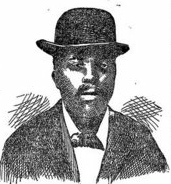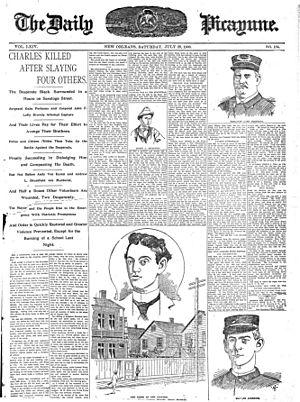Robert Charles riots facts for kids
Quick facts for kids Robert Charles riots |
||||
|---|---|---|---|---|
| Date | July 23 – July 28, 1900 | |||
| Location |
New Orleans, Louisiana, United States
|
|||
| Caused by | White reaction to killing of policemen | |||
| Goals | Suppression of African Americans; | |||
| Parties to the civil conflict | ||||
|
||||
| Lead figures | ||||
|
||||
| Casualties | ||||
| Death(s) | 28 | |||
| Injuries | 61 (mostly blacks) | |||
| Arrested | 19 (10 blacks and 9 whites indicted for murder) | |||
The Robert Charles riots of July 24–27, 1900 in New Orleans, Louisiana were sparked after African-American laborer Robert Charles fatally shot a white police officer and escaped arrest. A large manhunt for him ensued, and a white mob started rioting. The manhunt for Charles began on Monday, July 23, 1900, and ended when Charles was killed on Friday, July 27.
White rioting continued after Charles had died. A total of 28 people were killed in the riots, including Charles. More than 50 people were wounded in the riots, including at least 11 who had to be hospitalized.
Robert Charles (b. circa 1865) had come to New Orleans from Mississippi. He was a self-educated activist for civil rights. He believed in self-defense for the African-American community and encouraged African Americans to move to Liberia to escape racial discrimination.
Background
White supremacy
Louisiana was a slave society before the American Civil War, with hundreds of enslaved people working on each of numerous large cotton and sugar cane plantations, and many others in smaller groups, including in port cities such as New Orleans. Some also worked on the steamboats that traveled the rivers. At the start of the 20th century, the population of New Orleans was recorded in 1900 at 208,946 'white' and 77,714 'negro' by the Twelfth Census of the United States. Among the latter were many mixed-race people, most of whose ancestors had formerly had a distinct status as free people of color before the Civil War, particularly during the years of French and Spanish control. They are also known as Creoles of color.
The white-dominated legislature, primarily Democrats, had passed a new state constitution in 1898 with provisions that disenfranchised most African Americans by making voter registration more difficult, through poll taxes, literacy tests and similar measures. After that, the Democratic-dominated legislature passed eight Jim Crow laws by 1900. These included a law establishing racial segregation for public facilities, including interstate railroad cars, which were nominally under federal law. Plessy vs. Ferguson (1896) was a Louisiana test case of segregation on interstate railroad cars, which was appealed to the US Supreme Court. Opponents argued that federal laws and constitutional rights should apply on interstate transportation, but the Court ruled the state could establish "separate but equal" facilities. In practice, however, the "separate" facilities were seldom equal.
These laws aggravated racial relations. Historian William Ivy Hair has written, "Signs of increasing animosity between the races were to be seen almost daily in New Orleans during June and July 1900. Both the police and press received an unprecedented number of complaints."
New Orleans newspapers contributed to racial tensions, as they were "becoming more stridently racist in their editorial columns and treatment of the news." The confrontational journalistic practices of Henry J. Hearsay and the States newspaper caused racial rifts in New Orleans.
Racial attitudes
In southern Louisiana, African Americans had been allowed much more freedom than in other areas, largely owing to the racial demographics in New Orleans particularly and its history. During the colonial period, New Orleans had developed three racial groups, as was typical of other French and Latin colonies: white, free persons of color (mixed race or gens de couleur libre), and enslaved black people. Robert Charles was classified as mixed-race (mulatto in the terms of the time) and his ancestors may have been free before the Civil War. In colonial French society, free people of color had more rights and often gained education, property and more skilled jobs and professions. After the United States takeover in the Louisiana Purchase, and particularly after Reconstruction, the increasingly numerous whites from United States southern Protestant culture worked to impose the Southern binary system of classifying everyone as black or white. Mixed-race people still formed a class elite in New Orleans.
By the 1900s the line of segregation separating whites and blacks (people of African descent) had been imposed in New Orleans culture, including the segregation by color on New Orleans' streetcars.
Events
Altercations
At approximately 11 p.m. on July 23, 1900, three white police officers, Sergeant Jules C. Aucoin, August T. Mora, and Joseph D. Cantrelle, investigated reports of "two suspicious looking negroes" sitting on a porch in a predominantly white neighborhood. They found Robert Charles and his roommate, 19-year-old Leonard Pierce, at the scene. The policemen questioned the two men, demanding to know what they "were doing and how long they had been there." One of the two men replied that they were "waiting for a friend." Charles stood up, which the police took as an aggressive move. Mora and Charles pulled guns and exchanged shots. Both men received non-lethal wounds to the legs. Charles fled to his residence. Pierce was covered by a police officer when Charles ran.
Charles had returned to his residence by early the next morning, when police were trying to find him. Captain Day and a patrol wagon approached Charles's residence on the 2000 block of Fourth Street at approximately 3 a.m. on the morning of July 24, 1900. When the police tried to apprehend Charles, he fired upon them and killed Day and Peter Lamb. The remaining policemen took refuge in a nearby room and Charles escaped. The police started a manhunt.
Manhunt and riot
On July 24 a crowd of whites gathered on Fourth Street. The crowds dispersed when they were falsely told Charles had been located and jailed. On July 25, Acting Mayor William L. Mehle (Mayor Paul Capdevielle was out of town) announced a $250 reward for the arrest of Charles, while issuing a proclamation urging peace. In contrast, New Orleans newspapers, particularly the Times-Democrat, blamed the black community and called for action.
In the following days, several riots occurred as mobs of whites roamed the streets. Charles had taken refuge at 1208 Saratoga Street, where he remained safe from the police until Friday, July 27. Upon receiving a tip about the whereabouts of Charles from an informant, police searched the house. As the officers neared Charles' hiding place beneath the stairs, Charles opened fire. Other officers quickly brought in reinforcements to both surround Charles and to protect the black residents from white mob.
A fire captain and other volunteers snuck into the first floor beneath Charles and ignited a mattress. The smoke from the mattress forced Charles out of the house. As he tried to escape, he was killed by Charles A. Noiret, a medical student and member of the special police (a militia group of volunteer citizens).
Aftermath
After learning of Charles' death, mobs of white people renewed their attacks on black residents. By the next morning, the special police and state militia had quelled the rioting and brought the city under control.
The events in New Orleans received national coverage and had ramifications beyond the state. Lillian Jewett was fundraising at a Boston, Massachusetts meeting hours after Charles' death to raise money for the injured in New Orleans. The Louisiana Times Picayune reported "Insane Ravings at a Boston Meeting". A group of wealthy young white men from New Orleans had formed the Green Turtles the previous year. This group required an "oath of allegiance to white supremacy and the Democratic Party."
After the Robert Charles riots, whites intensified and increased the reach of racial segregation in the state.
New Orleans jazz pianist Jelly Roll Morton recounted the 1900 riot in his 1938 oral history recorded for the Library of Congress.



